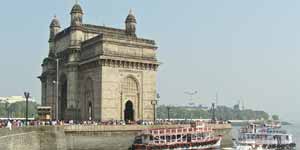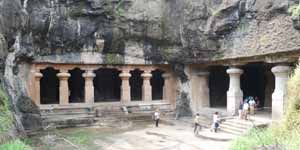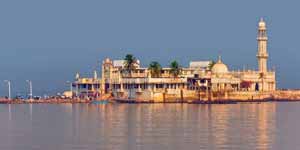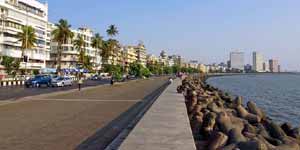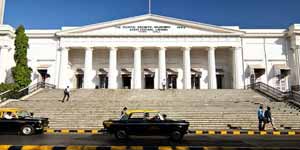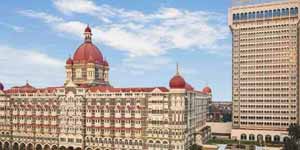
Chhatrapati Shivaji Terminus
Chhatrapati Shivaji Terminus is an outstanding example of late 19th-century railway architecture in the British Commonwealth, characterized by Victorian Gothic Revival and traditional Indian features, as well as its advanced structural and technical solutions. It became a symbol for Bombay (now Mumbai) as a major mercantile port city on the Indian subcontinent within the British Commonwealth.
The site on which this property is situated is associated with the origins of Mumbai as a city. Bombay Island had formed a coastal outpost of the Hindu in western India, but was not used for commerce. It was first passed to the Portuguese and then, in 1661, to the British. In 1667, the island was transferred to the East India Company, who was principally responsible for its commercial development. Merchants settled here from elsewhere, and the shipbuilding industry and the cotton trade prospered.
The town flourished, especially after the building of railway connections with the inland and the opening of the Suez Canal in 1869. With the development of trade, the Governor of Bombay planned a series of works aiming at the construction of a more representative city.
History
Bori Bunder (alternatively "Bori Bandar") was one of the areas along the Eastern shore line of Mumbai, India which was used as a storehouse for goods imported and exported from Mumbai. In the area's name, 'Bori' mean sack and 'Bandar' means port or haven (in Persian); So Bori Bunder literally means a place where sacks are stored. In the 1850s, the Great Indian Peninsular Railway built its railway terminus in this area and the station took its name as Bori Bunder.On 16th April, 1853 the Great Indian Peninsula Railway operated the historic first passenger train in India from Bori Bunder to Thane covering a distance of 34 km, formally heralding the birth of the Indian Railways. The train between Bori Bunder and Thane was 57 minutes it was a distance of 35 km apart.
The station was eventually rebuilt as the Victoria Terminus, named after the then reigning Queen, and has been subsequently renamed Chhatrapati Shivaji Terminus (CSTM) after Maharashtra's and India's famed 17th century king. Though the shortened name is now CST, it still continues to be referred to as VT by the masses.
The station was designed by the consulting British architect Frederick William Stevens(1848-1900). Work began in 1878. He received 1,614,000 (US$30,504.6) as payment for his services. Stevens earned the commission to construct the station after a masterpiece watercolour sketch by draughtsman Axel Haig. The final design bears some resemblance to the St Pancras railway station in London. GG Scott's plans for Berlin's parliament building had been published four years before, and also has marked similarities to the station's design.
It took ten years to complete and was named "Victoria Terminus" in honour of the Queen and Empress Victoria; it was opened on the date of her Golden Jubilee in 1887. It cost £260,000 when it was finished in 1888, the highest for any building of that era in Bombay. This famous architectural landmark in Gothic style was built as the headquarters of the Great Indian Peninsular Railway. Since then, the station came to be known as Bombay VT.
Originally intended only to house the main station and the administrative offices of the Great Indian Peninsula Railway, a number of ancillary buildings have been added subsequently, all designed so as to harmonise with the main structure. A new station to handle main line traffic was erected in 1929. The original building is still in use to handle suburban traffic and is used by over three million commuters daily. It is also the administrative headquarters of the Central Railway.
In 1996, the Minister of Railways, Suresh Kalmadi, changed the name of the station to Chhatrapati Shivaji Terminus in honour of the great Maratha king Chhatrapati Shivaji.
Monuments in Mumbai
Monuments in Mumbai It is a beautiful city with a vibe that can't be felt anywhere else for anyone who lives in Mumbai. Yeah, residents of other metropolitans may have raised eyebrows after my comment, but you have to agree with me that Mumbai has something to do with it! Housing India's most successful film industry; some of Asia's biggest slums, and the most expensive in the world Homes with the largest tropical forest in an urban area, the town is a true representation of the diversity that India is renowned for. Not just that, when it comes to rich history, the city can fill in pages after pages and can give any place in the country a decent run for money when it comes to nightlife. The bottom line is that Mumbai really is a city to see in India, Everything that also has your minds engaged for days after the trip. There is enough for everybody, and enough to blow up one 's mind! Without further ado, let me share a list of top places to visit in Mumbai, so if you're planning a trip to this action-packed area, you 're not even missing one part of it.


